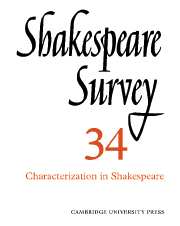Book contents
- Frontmatter
- Shakespeare’s Open Secret
- The Emergence of Character Criticism, 1774–1800
- Society and the Individual in Shakespeare’s Conception of Character
- Realistic Convention and Conventional Realism in Shakespeare
- On Expectation and Surprise: Shakespeare’s Construction of Character
- Shakespeare and the Ventriloquists
- The Rhetoric of Character Construction: Othello
- Characterizing Coriolanus
- The Ironic Reading of The Rape of Lucrece and the Problem of External Evidence
- The Unity of Romeo and Juliet
- No Abuse: The Prince and Falstaff in the Tavern Scenes of Henry IV
- Twelfth Night: The Experience of the Audience
- Plays and Playing in Twelfth Night
- Sceptical Visions: Shakespeare’s Tragedies and Jonson’s Comedies
- Shakespeare in Performance, 1980
- The Year's Contributions to Shakespearian Study 1 Critical Studies
- 2 Shakespeare’s Life, Times and Stage
- 3 Textual Studies
- Index
- Plate Section
Realistic Convention and Conventional Realism in Shakespeare
Published online by Cambridge University Press: 28 March 2007
- Frontmatter
- Shakespeare’s Open Secret
- The Emergence of Character Criticism, 1774–1800
- Society and the Individual in Shakespeare’s Conception of Character
- Realistic Convention and Conventional Realism in Shakespeare
- On Expectation and Surprise: Shakespeare’s Construction of Character
- Shakespeare and the Ventriloquists
- The Rhetoric of Character Construction: Othello
- Characterizing Coriolanus
- The Ironic Reading of The Rape of Lucrece and the Problem of External Evidence
- The Unity of Romeo and Juliet
- No Abuse: The Prince and Falstaff in the Tavern Scenes of Henry IV
- Twelfth Night: The Experience of the Audience
- Plays and Playing in Twelfth Night
- Sceptical Visions: Shakespeare’s Tragedies and Jonson’s Comedies
- Shakespeare in Performance, 1980
- The Year's Contributions to Shakespearian Study 1 Critical Studies
- 2 Shakespeare’s Life, Times and Stage
- 3 Textual Studies
- Index
- Plate Section
Summary
Can realism have anything to do with reality? I answer, yes, it can, but find that this innocent response now needs a careful defence. In his introduction to the eleventh issue of Communications, the issue devoted to vraisemblance, Tsvetan Todorov writes, ‘A work is described as having verisimilitude in so far as it tries to make us believe that it conforms to the real and not to its own laws; in other words, the vraisemblable is the mask in which the laws of the text are dressed up, a mask which we are supposed to take for relation to reality.’ We have here an assumption and a thesis. Todorov assumes that conformity to the real and conformity to literary laws are mutually exclusive; if you are doing the one you can’t be doing the other. And he asserts that artists in fact do the second; that, even when they claim to be addressing reality, they are really doing something quite different, namely following the laws of literature.
I submit that this assumption is wrong and that the thesis is by consequence also wrong. Reference to the real, so far from being at odds with adherence to convention, actually presupposes it. This is most obviously true at the level of language, which is endlessly formulaic, endlessly conventional. But if language cannot refer to reality we may as well all go home. It is fashionable to speak of the mysterious void which yawns between language and the world, a void constituted by the fatal heterogeneity of words and objects. But if words were indistinguishable from objects they could not be used to refer or designate. You don't point at a cat with a cat, you use your finger or a stick - or a word.
- Type
- Chapter
- Information
- Shakespeare Survey , pp. 33 - 38Publisher: Cambridge University PressPrint publication year: 1982
- 1
- Cited by

